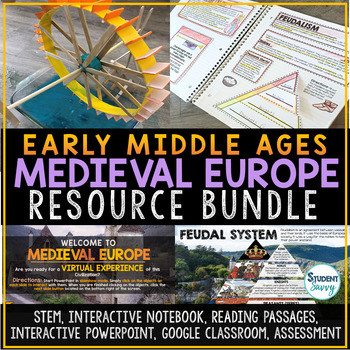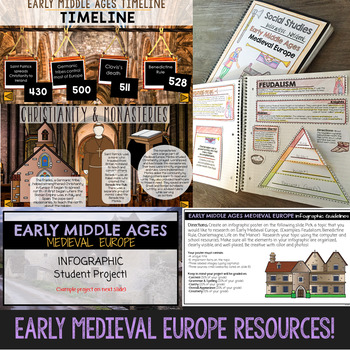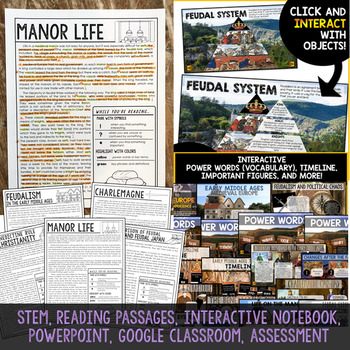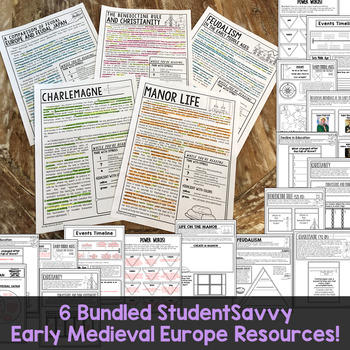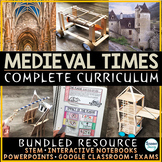Medieval Europe Activities Early Middle Ages Reading Passages Projects Timeline
- Zip
- Google Apps™
- Easel Activity

What educators are saying
Products in this Bundle (6)
showing 1-5 of 6 products
Also included in
- Enhance your Middle Ages curriculum with our Medieval Times and Early Modern Times Complete Curriculum Bundle, available in digital Google Classroom and PDF print formats. With over 1500 pages/slide of material, this comprehensive resource covers Early Byzantine, Early Islam, West Africa, MedievalPrice $190.00Original Price $314.93Save $124.93
Description
Bundle Description
Early Middle Ages (Feudalism) - Medieval Europe Activities Resource Bundle!
This bundled product contains the following 6 StudentSavvy resources!
Interactive Notebook
Reading Passages
Interactive PowerPoint
STEM Challenges
Google Classroom Student Projects
Assessments / Exam / Test
_________________________________________________________________
More information on each resource:
-Interactive Notebook
This product contains interactive cut and paste learning material for students to create an organized social studies interactive notebook.
Answer Key Included!
Topics covered in this unit include: Feudalism, Monasteries, Estates, Manors, Fiefs Charlemagne, Saint Benedict of Nursia, The Benedictine Rule, Saint Patrick, William I, Education and Decline, Christianity, Monk Communities, Knights, Lords, Peasants, Serfs, Vassals, Chivalry, Feudal Europe V.S. Feudal Japan
_________________________________________________________________
-Reading Passages
Questions & Answer Keys for Each of the 5 Reading Passages!
COMMON CORE ALIGNED!
Quick overview of topics covered in this resource include:
1.) Feudalism in the Early Middle Ages
-Introduction/Overview of how after the collapse of Rome, there was no large system of government.
-describes a decline in education and the changes after the fall of Rome (reduction in trade, decline in education, etc.) and how it impacted Europe
-eventually led to feudalism, basis of society.
-overview of feudalism (agreement between vassals and lords)
Keywords: feudalism, medieval, fiefs
2.) Charlemagne
-Overview of his history and how he created a European empire
-Describes how he was crowned Holy Roman Emperor
-Overview of all of his major accomplishments
(military campaigns, spreading Christianity, creating schools, etc)
3.) Manor Life
-Introduction of life on the manor. Describes what a manor consists of. Description of how it was it’s own micro-word and self-sustaining.
-describes the things that characterized the middle ages during the manor time period (no real government, very little trade, political chaos, kingdoms)
-overview and description of Early Medieval hierarchy (Kings, nobles, knights, peasants)
Keywords: manor, baron, fiefs, vassal, manor, lord, feudalism, serf, squire
4.) The Benedictine Rule and Christianity
-Overview of Christianity in Early Medieval Europe and how it spread.
-Describes missionaries, monks, Saint Patrick, monasteries, and the Benedictine Monks.
-Ways monks aided the communities (helped others read and write, healthcare, etc.)
-Describes who Saint Benedict of Nursia was and what the Benedictine Rule and Benedictine Order is and what the rules were that Benedictine monks must follow.
Keywords: monastery, The Benedictine Rule, bishop, monk,
5.) A Comparison of Feudal Europe and Feudal Japan
-Introduction to Feudal Europe and Feudal Japan
-Compares and contrasts the similarities and differences in Early Medieval Europe and Feudal Japan.
Keywords: Chivalry, Bushido, Feudalism, Zen Gardens, Epic Poetry, Haiku, Shintoism, Christianity
________________________________________________________________
-Interactive PowerPoint
This teaching resource is quite the virtual experience! This Medieval Times PowerPoint can be used as a powerful classroom presentation or students can click their way through it on individual computers.
***This product was created with the latest version of PowerPoint (2016). The effects and transitions may not display properly on older versions. Please use the Google Slides version if students are using Chromebooks.
Topics covered in this unit include: Feudalism, Monasteries, Estates, Manors, Fiefs Charlemagne, Saint Benedict of Nursia, The Benedictine Rule, Saint Patrick, William I, Education and Decline, Christianity, Monk Communities, Knights, Lords, Peasants, Serfs, Vassals, Chivalry, Feudal Europe V.S. Feudal Japan
_________________________________________________________________
-STEM Challenges
STEM & STEAM Challenges
Cross-curricular challenges for students who are studying Middle Ages and Medieval Times!
This resource has science, technology, engineering, and measurement activities to do with your upper elementary kids that will really enhance their learning!
There are 2 Early Middle Ages - Medieval Europe STEM Challenges in this pack. Each STEM Challenge has detailed directions, photo examples, a list of materials needed, prediction section, brainstorming section, trials 1, 2, & 3, final results section with drawings, and a reflection section.
The STEM Challenges include:
1. Battering Ram Challenge
Using a list of supplies, STEM teams must design and build a battering ram. The ram must be suspended in the air by string and must effectively swing back and forth to exert force on an opposing structure. The battering ram must also have wheels and axles, moving forward and backward. A cover (roof) for protection from oncoming attacks is recommended but not required..... (more instructions and planning pages are given in the resource)
2. Watermill Challenge
Using a list of supplies, STEM teams must create a watermill. The watermill must properly spin when water is poured at the top of the wheel without falling apart. STEM teams have 3 days to complete this challenge.
(more instructions and planning pages are given in the resource)
_________________________________________________________________
-Google Classroom Student Projects
3 digital projects for your students!
Medieval Times / Middle Ages Series
This product contains 3 digital projects that students can complete using Google Slides! This resource has a brochure project, a timeline project, and a info-graphic / poster project.
Each student-centered project has a sample project, answer key, and detailed project instructions for the students.
Info-graphic / Poster Project
Students pick a topic that they would like to research on Early Medieval Europe (Ex: Feudalism, Benedictine Rule, Charlemagne, Life on the Manor, etc.) All of the elements in the info-graphic must be organized, clearly visible, and well placed. Creativity with color and photos is a must! **More instructions found in the resource
Timeline Project
Using a template, students design a timeline of important events during Medieval Europe. Students can add images, text, and other media to their timelines.
It is up to the teacher to add or change time periods that align with school resources.
Brochure Project
Using a template, students design a brochure that highlights important facts and topics of Medieval Europe such as: Feudalism, Christianity and Monasteries, Manor Life, etc.
_________________________________________________________________
-Exam - Test - Assessment
This resource contains an assessment that has vocabulary matching, fill in the blank, short answer, essay, and an info-graphic. It has 18 questions total.
It also contains an ANSWER KEY and an EDITABLE PowerPoint file.
Tips for Savvy TpT Shoppers:
How to receive credit on TpT to use for future purchases:
• Go to your My Purchases page. Under each purchase you'll see a Provide Feedback button. Simply click it and you will be taken to a page where you can give a quick rating and leave a short comment for the product. I value your feedback greatly as it helps me determine which products are most valuable for your classroom so I can create more for you.
Be the first to know about my new discounts, FREEBIES, and products:
• Look for a green star near the top of any page within my store and click it to become a follower. You will now be able to see FREEBIES and customized emails from my store!
©2019 StudentSavvy
All rights reserved by author. Permission to copy for single classroom use only. Electronic distribution limited to single classroom use only. (unless you purchase the multiple license)

